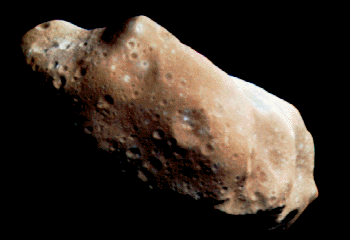
Deep Impact: The Sky Is Falling
by Peter Backus

|


The Earth is struck by a hurtling mountain of rock (or ice). A wall of fire and water rages around the world, destroying everything in its path. Is this the end of modern civilization? Will we go the way of the dinosaurs? Or is this just a very impressive media campaign for the "sure hit" summer blockbusters?
In a sense, the Earth we know is a product of impacts. In the early history of the Solar System, the Earth and the other planets formed by the gradual accretion of the debris left over from the formation of the Sun. We now believe that after the Earth was mostly assembled a large object, perhaps the size of Mars, struck the Earth a glancing blow. A large piece of the Earth's outer layers was shattered and sent into orbit about the Earth. This material later formed the Moon.
Impact of smaller objects, from dust grains to multi-kilometer sized objects, continued for millions of years. Some of these objects were comets, dirty snowballs roughly ten kilometers across. We now believe the most of the water on Earth was delivered by these comets.
The pummeling of the Earth continued in episodes that spanned several hundred million years. Some of these episodes of bombardment were so intense that the oceans were evaporated and the surface sterilized by the heat. It is possible that primitive life arose several times on the Earth before finally taking hold after the last period of massive impacts.
 In the geological history of the Earth we see evidence of other large impacts. Some of these impacts coincide with massive extinctions in the paleontologic record. At some epochs in the past, more than 90% of the species suddenly disappeared (suddenly on a geological timescale). One such event occurred 65 million years ago at the transition between the Cretaceous and Tertiary periods. The dinosaurs, the dominant creatures for 150 million years, along with many other species disappeared. We now have evidence that the dinosaurs were wiped out by a massive impact that occurred in an area just off the coast of the Yucatan peninsula.
In the geological history of the Earth we see evidence of other large impacts. Some of these impacts coincide with massive extinctions in the paleontologic record. At some epochs in the past, more than 90% of the species suddenly disappeared (suddenly on a geological timescale). One such event occurred 65 million years ago at the transition between the Cretaceous and Tertiary periods. The dinosaurs, the dominant creatures for 150 million years, along with many other species disappeared. We now have evidence that the dinosaurs were wiped out by a massive impact that occurred in an area just off the coast of the Yucatan peninsula.
 Sometimes the Earth encounters more resilient objects, small asteroids and asteroid fragments. About 50,000 years ago a 30 meter diameter iron meteor struck the southwestern U.S. The resulting 20 megaton explosion left a crater that is 1.2 km across and 200 meters deep. More recently, in 1996, a small meteor hit Honduras leaving a 50 meter wide crater. Smaller meteors are more common. In the last century a number of houses have been hit (two in the same neighborhood!) and at least one car.
Sometimes the Earth encounters more resilient objects, small asteroids and asteroid fragments. About 50,000 years ago a 30 meter diameter iron meteor struck the southwestern U.S. The resulting 20 megaton explosion left a crater that is 1.2 km across and 200 meters deep. More recently, in 1996, a small meteor hit Honduras leaving a 50 meter wide crater. Smaller meteors are more common. In the last century a number of houses have been hit (two in the same neighborhood!) and at least one car.
So, the Earth is still being hit by both comets and asteroids. Fortunately, the big ones are relatively rare.
And then there was asteroid 1997XF11. Originally predicted to pass only 50,000 km from the Earth in 2028, with the chance of collision "not out of the question", it quickly became the "doomsday rock" in the media. When the estimates were revised the next day, the media ridiculed the astronomers rather than the irresponsible and irrational reporting.
But what are the chances of a big one actually hitting? We're just beginning to understand the number and nature of near Earth asteroids. NASA has launched the Near Earth Asteroid Rendezvous (NEAR) mission to study the asteroid Eros. A few groups of astronomers, such as Project Spacewatch, search for asteroids whose orbits pass close to the Earth's orbit. Such "Earth-crossing" asteroids pose the greatest danger to our planet, yet the number of astronomers searching for these objects is smaller than the staff of an average McDonalds restaurant. The data so far suggest that your chances of being killed by the cataclysmic impact of an asteroid or comet are similar to your chance of dying in an airplane crash.
If the object can be detected soon enough, something can be done. The more advance warning we have, the better the chances of successfully deflecting or destroying the object. In the case of a comet (as in "Deep Impact"), it would be much easier and effective if a space mission could rendezvous with the comet while it was still in the outer Solar System. This would probably only be possible for predictable periodic comets like Halley's comet. If the comet is far from the Sun, the problem of sudden, explosive outgassing (as seen in the movie) is minimized. The comet is also moving at a lower velocity, so rocket engines fueled with cometary ice might gradually change its motion to cause it to miss the Earth. Small explosions might also be used to achieve the same effect.
If comet is hurtling through the inner Solar System on a collision course with the Earth, the problem is much more difficult. More force is required to make a significant deflection in its path. Applying such force through nuclear bombs might fragment the comet. An alternative might be to try to shatter and disperse the 10 km block of ice with a large number of well-placed nuclear bombs. But, remember, a 100 meter piece of a comet flattened thousands of square kilometers of Siberia. There are a million such pieces in a typical comet. A million 10 megaton explosions would be a global disaster.
If the object threatening the Earth is an asteroid, as in "Armageddon", the key again is early warning. With enough time, rockets or explosions could deflect the path of the asteroid enough to cause it to miss the Earth. If we have little warning, we might have to try massive nuclear explosions. The effectiveness of such explosions will depend on the nature of the asteroid. Some asteroids, condrites, are an amalgamation of materials that might shatter and disperse under nuclear bombardment. Other asteroids are essentially lumps of iron and may not be so easily shattered.
Suggestions? Comments? Fill out our Feedback Form.